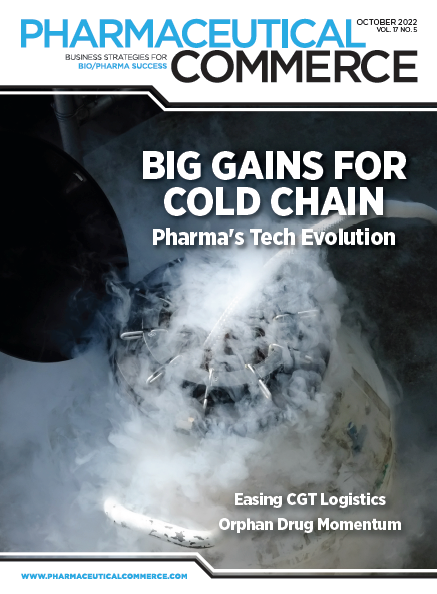Building the Cold Chain of the Future
With today's greater combination of technology and know-how, we must design new ways to handle sensitive pharmaceuticals—and do it together
As technology and our understanding of disease advances, how we transport, handle, and store temperature-controlled pharmaceutical products is rapidly evolving. While cold chain products are not new to the industry, the amount of products that need specific temperatures is increasing. In fact, in 2021, 58% of the 50 top-selling pharmaceuticals in the US required cold chain handling and storage.
And, as the number of personalized medicines in the drug pipeline continues to rise—most of which require freezer or deep-freeze temperatures—the need for more cold storage and handling will also increase.
Of course, this growing need for more specialized handling is taking place on top of an already taxed supply chain, exacerbated by the pandemic, a shifting online shopping culture, and even weather pattern changes.
All of this says it’s time to rethink the cold chain as we know it, focusing on a future where we deliver medicine in new and innovative ways by working with other industries and businesses, ultimately building the cold chain of the future.
Rethinking the packaging
While there have been advancements in the packaging of temperature-controlled pharmaceuticals, the overall methods have remained the same—either one-use shipping containers that can contribute millions of pounds of waste to landfills, bulky reusable freezer technologies, or refrigerated trucks. These options are used because they fit within the constraints and complexities of the shipping industry; however, while these methods have worked thus far, the influx of products needing specific temperatures, along with shipping delays caused by the overtaxed supply chain, means that these products could be at risk of losing efficacy—or worse—endangering patient lives.
Joel Wayment

In our case, we recently joined forces with Ember Technologies, known for its smart mugs that can keep drinks at the perfect temperature with an app, to develop a new way to ship temperature-controlled products. By working together, our team was able to understand new technologies, and gain new ideas, while the Ember team was able to better understand the intricacies of the supply chain within the healthcare space, and what’s needed to keep these highly expensive and life-saving medications safe for patients.
This partnership led to the initial design of the Ember Cube, a reusable refrigerated shipping container that uses novel technology designed specifically for these temperature-controlled products.
Finding real-time visibility
We know where our shoes and cat food purchases are in the supply chain—so, why not our medications? The real-time monitoring of pharmaceutical products, and specially temperature-controlled therapies, is not a new ask. In fact, it is largely considered one of the most serious challenges affecting the pharmaceutical industry, with 32% of drug manufacturer executives stating that temperature monitoring is their most urgent concern.
Manual checks for temperature excursions may have worked for 2-8°C products, but as the ultra-low and cryo products come to market, these get harder to complete, requiring better technology.
This is punctuated by research that shows that the biopharma industry loses approximately $35 billion every year due to temperature failures. Understanding where products are in the supply chain, when they will get to their destination, and potential risks that might be encountered is no longer a nice to have, but a necessity for the future of the supply chain and the safety of patients.
As part of our project with Ember, the need for real-time tracking of each Ember Cube became essential to the design of the product. We worked with their team to develop a solution that was trackable on a cloud-based dashboard complete with real-time temperature and location monitoring.
Not only does the cloud aspect enable the logistics team to understand where it is, but this could eventually build into access for providers, patients, etc.
Beyond packaging for individual products, we have also found that a temperature-controlled dedicated transportation network can also protect the integrity of these products. Unlike other solutions, these networks use geofencing to track treatments in real-time, which enables larger shipments of products while still keeping the focus on the supply chain visibility. This is especially important because delays in transit are inevitable. While we may not be able to prevent these delays 100% of the time, we can better protect the product during a delay, thereby mitigating the risk of product loss and the potential of a patient not getting their medication when they need it.
Becoming more sustainable
Beyond the technical aspects, sustainability is what the future looks like from an environmental standpoint, especially when some research shows that the pharma industry may emit more greenhouse gases than the automotive industry.
Jason Cook

Currently, the most common types of cold chain shipments use single-use materials, such as polystyrene and cooling packs, due to the cost-effectiveness and flexibility of these designs, and many manufacturers are looking to invest in more sustainable options in order to meet their aggressive sustainability targets. This has led to the adoption of programs with life cooler returns growing in popularity; however, the success rate of getting coolers back is still low.
With that in mind, we knew the ability to return the Ember Cube shippers needed to be as seamless as possible, so we worked with Ember to develop an e-ink screen that displays the return address with just the touch of a button, something that was designed to save more than seven tons of waste from landfills each year.
Building the space
It’s important to note that the cold chain not only involves the active shipping and handling of temperature-controlled products, but the storage as well. As more drugs get approval from the FDA, and especially with so many temperature-controlled products, it is vital that there is freezer space and capacity to keep these products viable.
Whether the drugs are stored in manufacturers’ warehouses, with third-party logistics providers (3PLs), or even hospitals and pharmacies, their storage and capacity is something that remains one of the largest challenges for the pharmaceutical and healthcare industries, according to a 2022 ASHP Forum.
Recent supply chain disruptions of certain parts have also delayed building more freezer space for many in the industry, but this space remains vital for these products to be developed.
Training the workforce
Finally, the creation of the cold chain of the future needs a workforce to match the evolving technology. The pandemic has significantly disrupted the supply chain industry; in fact, 44% of operations leaders referenced worker shortages and employee turnover as one of their biggest operations challenges in 2022 in a recent PwC survey.
The cold chain supply chain not only demands a consistent workforce, but a well-trained workforce to handle the specific temperature requirements, pack outs, and monitoring that is required for these highly sensitive products. To compete in the workforce, the pharmaceutical industry must focus on a positive employee experience, including great onboarding and training, and even partnering with other experts when necessary.
It is only a matter of time before the future cold chain becomes a reality. Through collaboration and innovation, we will get to this future faster.
About the Authors
Joel Wayment is VP of Operations at Cardinal Health Third Party Logistics Services. Jason Cook is Director of Operations at Cardinal Health.
